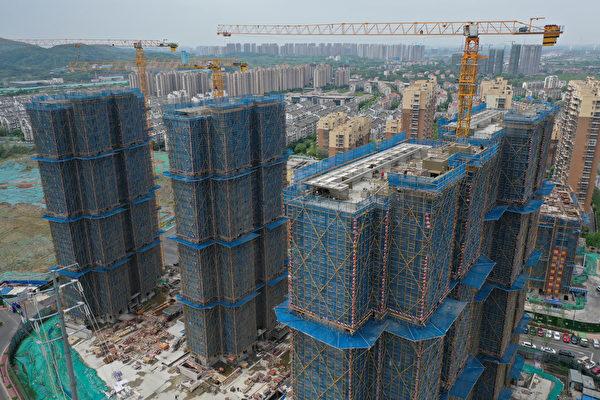Beijing has recently ordered local governments to accelerate the listing and issuance of real estate investment trusts (REITs) in the infrastructure sector, pledging to grant policy support.
The Chinese Communist Party (CCP) is currently seeking to strengthen infrastructure funding channels and alleviate local debt risk, while easing pressure on the central government’s finance.
In June 2021, when China’s first nine infrastructure REITs went public, former Chinese Finance Minister Lou Jiwei said the time had come to remove the debt risk of local government financing vehicles (LGFVs). The LGFV is the primary source of hidden debts for local governments.
By the end of 2020, the total debt of LGFVs soared to more than $8 trillion from $2.4 trillion in 2013, according to a report released by Goldman Sachs in September 2021. That exceeded half the size of China’s gross domestic product (GDP) in 2020, larger than the amount of official outstanding government debt.
An official document released on Dec. 29, 2021, required local governments to push the issuance of REITs in the infrastructure sector as soon as possible. The main objectives of the move is to revitalize asset stock, optimize debt structure, and relieve debt pressure, according to the report.
“Evidently, reducing local government debt risk is the main reason for quickening the issuance of REITs,” Hong Kong-based financial analyst Katherine Jiang told The Epoch Times.
“Infrastructure investment is one of the leading instruments that the CCP local governments use to drive economic growth. However, such investment is largely supported by credit expansion, which has allowed the communist regime to stockpile huge debts over the past two decades.”
Beijing is in the process of shifting the role of local governments from borrowers to asset managers through REITs, thereby transferring their risk.
In June 2021, the first nine publicly-offered REITs by Chinese standard raised a total of $4.9 billion when listed domestically.
The chairman of the China REITs forum 2020, Xu Xianping, said in September 2020 that the potential size of China-standard public REITs products was about $1 to $2 trillion, which could leverage about $2.5 to $6.5 trillion in investment. He is also a counsellor of the CCP’s State Council and a distinguished professor at Peking University’s Guanghua School of Management.
The local governments have formed tens of thousands of financing platforms to help them conduct debt raising since the start of this century, most of which are in the form of urban investment and development companies. Consequently, they have accumulated a huge amount of debt.

“Today, with a slowing economy, fiscal shortfalls, and heavy debts, the CCP faces a shortage of funding sources if it expects to continue investment in the infrastructure sector,” said Jiang. “In this context, encouraging REITs becomes a ‘way out.’”
That would help the CCP create the illusion of a booming economy, which in turn will appeal to international capital, whose arrival will keep invigorating the ruling CCP in China, said Jiang.
The year 2021 was disastrous for Chinese property developers. The domestic real estate industry was trapped in a liquidity crisis, with top players like Evergrande, Fantasia, and Kaisa defaulting on their bonds one after another.
In response to tight liquidity, numerous developers reined in land purchases, making it extremely difficult for local governments to maintain their fiscal spending via land sales. This marked the end of China’s era of land-dependent finance. The risk of local government default or even bankruptcy has sharply increased. The financial community has described the colossal liability of local governments as a “ticking time bomb” that could explode at any time.
A survey of 86 first- and second-tier cities conducted by China’s Data Hub and Tencent Finance shows that in 2021, 85 had a debt-GDP ratio of more than 100 percent; and 75 doubled their debt ratio, compared to the previous year.
Among China’s four first-tier cities, both Beijing and Guangzhou had a debt ratio of over 200 percent, Shanghai at 122 percent, with only Shenzhen within a safe range, less than 20 percent, according to the survey. China’s top 10 indebted cities have an average ratio over 500 percent, with Guiyang being the most indebted at 929 percent.
When land revenue is not enough to keep local governments operating, the debt crisis could get worse. By the end of 2021, the third-tier city of Hegang had technically gone bankrupt, whose government announced a financial restructuring plan on Dec. 23, 2021, and suspension of hiring civil servants. The notice hinted that local authorities would seek financial support from higher-level governments.
Currently, the Chinese communist regime is speeding up REITs listing and expanding the size of issuing in the infrastructure sector, in a bid to slash hidden local debt stock and minimize the risk of default or bankruptcy.
While the central government is eager to reduce local debt load and deleverage and has promised policy support, local governments—at least so far—are reluctant to package their good quality real estate and infrastructure into REITs for listing. They are not concerned about future repayment because they will most likely obtain cheap loans from state-owned banks by mortgaging excellent resources.
“The CCP wants to deleverage and secure growth,” said Jiang. “This has invariably been a paradox in the past. Despite its attempts to cut government debt, the CCP usually returns to its old path of relying on credit expansion to boost investment and spur the economy, thus falling into an even more dangerous, vicious cycle.”
So far, the CCP has included infrastructure REITs in its future five-year planning, which it expects to function as a powerful instrument to relieve local governments from their deepening debt crisis.
Although issuing REITs is conducive to the central government’s risk management, its prospects are unpredictable for investors, whose returns depend on the quality and operation of REITs’ targets. The risk of policy changes may in turn directly affect target operational stability. A case in point is the array of real estate policies that Beijing rolled out last year, which discouraged developers.
“The degree of an economy’s prosperity affects the sources of returns from infrastructure REITs,” Jiang said. “An apparent slowdown in the Chinese economy could add uncertainty to their prospects, too.”






